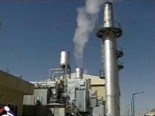 U.N. inspectors got their first look today inside a once-secret uranium enrichment facility that has raised Western suspicions about the extent of Iran’s nuclear program. The semiofficial Mehr news agency reported the four-member team visited the heavily protected facility, carved into a mountainside south of Tehran. The tour marked the first independent examination of the site, but no results were expected until after the inspectors leave Iran later this week.The review also coincides with the countdown to Iran’s expected decision on whether to accept a U.N.-brokered deal to process its nuclear fuel abroad – a plan designed to ease Western fears about Iran’s potential ability to produce weapons-grade material.
U.N. inspectors got their first look today inside a once-secret uranium enrichment facility that has raised Western suspicions about the extent of Iran’s nuclear program. The semiofficial Mehr news agency reported the four-member team visited the heavily protected facility, carved into a mountainside south of Tehran. The tour marked the first independent examination of the site, but no results were expected until after the inspectors leave Iran later this week.The review also coincides with the countdown to Iran’s expected decision on whether to accept a U.N.-brokered deal to process its nuclear fuel abroad – a plan designed to ease Western fears about Iran’s potential ability to produce weapons-grade material.
The disclosure last month of Iran’s second enrichment facility – known as Fordo after a village believed to have the largest percentage of fighters killed in the 1980-88 war with Iraq – raised international suspicion over the extent and aim of Tehran’s nuclear program.
But Iran says that by reporting the existence of the site voluntarily to the U.N.’s nuclear watchdog, it “pre-empted a conspiracy” against Tehran by the U.S. and its allies who were hoping to present the site as evidence that Iran was developing its nuclear program in secret.
Iran also has promised to respond later this week on U.N.-drafted proposal to have its nuclear fuel processed outside the country. Iran claims it only seeks peaceful reactors for research and energy.
Although Iran has not given its official answer on the proposed nuclear deal – discussed last week after talks in Vienna with the United States, France and Russia – there are increasing doubts that Iran’s leadership will come on board.
Yesterday, Parliament Speaker Ali Larijani claimed the West was trying to “cheat” Iran under the deal that would ship most of Iran’s uranium to Russia for reactor-ready enrichment.
Larijani, the country’s former nuclear negotiator, said Iran prefers to buy the nuclear fuel it needs for a reactor under construction that makes medical isotopes.
He did not specifically address the fuel needs for Iran’s planned Russian-built full-scale reactor, but Russia is required to provide fuel as part of agreement to build it for Iran in the southern city of Bushehr. The reactor is nearly operational.
Rejection of the U.N. deal would force the United States and its allies to either return to talks or step up demands for greater economic sanctions.
The four-member delegation from the International Atomic Energy Agency is led by Herman Nackaerts, director of IAEA’s division of operations department of safeguards. The inspectors are expected to stay three days in Iran.
The inspectors are expected to compare Iran’s engineering plans with the actual layout of the plant, interview employees and take environmental samples to check for the presence of nuclear materials.
Iranian lawmakers said the visit was evidence that Iran is open about its nuclear activities.
“IAEA inspectors’ visit to Fordo shows that Iran’s nuclear activities are transparent and peaceful,” the official IRNA news agency quoted lawmaker Hasan Ebrahimi as saying.
The Fordo uranium enrichment site, about 20 miles (30 kilometers) north of Qom, is protected by military installations including missile silos and anti-aircraft batteries, Iranian officials said last month.
Iran says the facility won’t be operational for another 18 months.
The small-scale site is meant to house no more than 3,000 centrifuges – much less than the estimated 8,000 machines at Natanz, Iran’s known industrial-scale enrichment facility. Still, the enriching machines in Qom facility will produce nuclear fuel, which could possibly be further enriched into material for atomic warheads.
Iran says it has built the facility inside a mountain next to a military site to protect its nuclear activities in case of an attack by the U.S. or Israel.
A recent satellite image provided by DigitalGlobe and GeoEye shows a well-fortified facility built into a mountain about 20 miles northeast of Qom, with ventilation shafts and a nearby surface-to-air missile site, according to defense consultancy IHS Jane’s, which did the analysis of the imagery. The image was taken in September.
GlobalSecurity.org analyzed images from 2005 and January 2009 when the site was in an earlier phase of construction and believes the facility is not underground but was instead cut into a mountain. It is constructed of heavily reinforced concrete and is about the size of a football field – large enough to house 3,000 centrifuges used to refine uranium.
Iranian officials say the site was selected after a careful study by experts. They say it was formerly an ammunition depot.
{GlobalSecurity.org/Los Angeles Times/Noam Amdurski-Matzav.com Newscenter}












Whatever happens is not good. If Iran doesn’t stop with it’s building nucleur arms, they can then go and attack Israel with it. And if they agree to stop making nucleur arms( we wouldn’t even deal with the compromise involving Russia ,because Russia is not any more trustworthy than Iran, and they in fact have alot to do with why Iran has such facilities in the first place)then all the world pressure is going to be turned on Israel that they too should give up on their nucleur arms, with the reasoning; if Iran did it, then you should too. So either way, we are in the frypan.